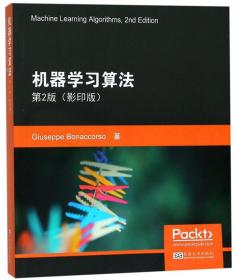
机器学算法 第2版(影印版) 英文原版书 (意)朱塞佩·博纳科尔索(giuseppe bonaccorso)
新华书店全新正版书籍 支持7天无理由
¥ 70.5 6.5折 ¥ 108 全新
库存4件
作者(意)朱塞佩·博纳科尔索(giuseppe bonaccorso)
出版社东南大学出版社
ISBN9787564182915
出版时间2019-03
版次1
装帧平装
开本16
页数508页
字数636千字
定价108元
货号xhwx_1201871720
上书时间2024-07-04
- 在售商品 暂无
- 平均发货时间 28小时
- 好评率 暂无
- 最新上架
商品详情
- 品相描述:全新
- 正版特价新书
- 商品描述
-
目录:
preface
chapter 1: a gentle introduction to machine learning
introduction - classic and adaptive machines
descriptive analysis
predictive analysis
only learning matters
supervised learning
unsupervised learning
semi-supervised learning
reinforcement learning
putational neuroscience
beyond machine learning - deep learning and bio-inspired adaptive systems
machine learning and big data
summary
chapter 2: important elements in machine learning
data formats
multiclass strategies
one-vs-all
one-vs-one
learnability
underfitting and overfitting
error measures and cost functions
pac learning
introduction to statistical learning concepts
map learning
mamum likelihood learning
class balancing
resampling with recement
smote resampling
elements of information theory
entropy
cross-entropy and mutual information
divergence measures between two probability distributions
summary
chapter 3: feature selection and feature engineering
scikit-learn toy datasets
creating training and test sets
managing categorical data
managing missing features
data scaling and normalization
whitening
feature selection and filtering
principal ponent analysis
non- matrix factorization
sparse pca
kernel pca
independent ponent analysis
atom extraction and dictionary learning
visualizing high-dimensional datasets using t-sne
summary
chapter 4: regression algorithms
linear models for regression
a bidimensional example
linear regression with scikit-learn and higher dimensionality
r2 score
ened variance
regressor analytic expression
ridge, lasso, and elastiet
ridge
lasso
elastiet
robust regression
ransac
huber regression
bayesian regression
polynomial regression
isotonic regression
summary
chapter 5: linear classification algorithms
linear classification
logistic regression
implementation and optimizations
stochastic gradient descent algorithms
passive-aggressive algorithms
passive-aggressive regression
fin the optimal hyperparameters through a grid search
classification metrics
confusion matrix
precision
recall
f-beta
cohens kappa
global classification report
learning curve
roc curve
summary
chapter 6: naive bayes and discriminant analysis
bayes theorem
naive bayes classifiers
naive bayes in scikit-learn
bernoulli naive bayes
multinomial naive bayes
an example of multinomial naive bayes for text classification
gaussian naive bayes
discriminant analysis
summary
chapter 7: support vector machines
linear svm
svms with scikit-learn
linear classification
kernel-based classification
radial basis function
polynomial kernel
sigmoid kernel
custom kernels
non-linear examples
v-support vector machines
support vector regression
an example of svr with the airfoil self-noise dataset
introducing semi-supervised support vector machines (s3vm)
summary
chapter 8: decision trees and ensemble learning
binary decision trees
binary decisions
impurity measures
gini impurity index
cross-entropy impurity index
misclassification impurity index
feature importance
decision tree classification with scikit-learn
decision tree regression
example of decision tree regression with the concrete pressive
strength dataset
introduction to ensemble learning
random forests
feature importance in random forests
adaboost
gradient tree boosting
voting classifier
summary
chapter 9: clustering fundamentals
clustering basics
k-nn
gaussian mixture
fin the optimal number of ponents
k-means
fin the optimal number of clusters
optimizing the inertia
silhouette score
calinski-harabasz index
cluster instability
evaluation methods based on the ground truth
homogeneity
pleteness
adjusted rand index
summary
chapter 10: advanced clustering
dbscan
spectral clustering
online clustering
mini-batch k-means
birch
biclustering
summary
chapter 11 : hierarchical clustering
hierarchical strategies
agglomerative clustering
dendrograms
agglomerative clustering in scikit-learn
connectivity constraints
summary
chapter 12: introducing remendation systems
naive user-based systems
implementing a user-based system with scikit-learn
content-based systems
model-free (or memory-based) collaborative filtering
model-based collaborative filtering
singular value deition strategy
alternating least squares strategy
als with apache spark mllib
summary
chapter 13: introducing natural language processing
nltk and built-in corpora
corpora examples
the bag-of-words strategy
tokenizing
sentence tokenizing
word tokenizing
stopword removal
language detection
stemming
vectorizing
count vectorizing
n-grams
tf-idf vectorizing
part-of-speech
named entity recognition
a sample text classifier based on the reuters corpus
summary
chapter 14: topic modeling and sentiment analysis in nlp
topic modeling
latent semantic analysis
probabilistic latent semantic analysis
latent dirichlet allocation
introducing word2vec with gensim
sentiment analysis
vader sentiment analysis with nltk
summary
chapter 15: introducing neural works
deep learning at a glance
artifi neural works
ml with keras
interfacing keras to scikit-learn
summary
chapter 16: advanced deep learning models
deep model layers
fully connected layers
convolutional layers
dropout layers
batch normalization layers
recurrent neural works
an example of a deep convolutional work with keras
an example of an lstm work with keras
a brief introduction to tensorfiow
puting gradients
logistic regression
classification with a multilayer perceptron
image convolution
summary
chapter 17: creating a machine learning architecture
machine learning architectures
data collection
normalization and regularization
dimensionality reduction
data augmentation
data conversion
modeling/grid search/cross-validation
visualization
gpu support
a brief introduction to distributed architectures
scikit-learn tools for machine learning architectures
pipelines
feature unions
summary
other books you may enjoy
index
内容简介:
机器学因运用大数据实现强大且快速的预测而大受欢迎。然而,其强大的输出背后,真正力量来自复杂的算法,涉及大量的统计分析,以大数据作为驱动而产生实质的洞察力。这本第2版的机器学算法引导您取得与机器学过程中的主要算法相关的显著开发结果,并帮助您加强和掌握有监督,半监督和加强学等领域的统计解释。一旦全面吃透了算法的核心概念,您将基于很广泛的库(如clkit.、nltk、tenorflow和kera)来探索现实世界的示例。您将发现新的主题,如主成分分析(pca)、独立成分分析(ica)、贝叶斯回归、判别分析、不错聚类和高斯混合等。
相关推荐
-

机器学习算法 第2版(影印版)
全新无锡
¥ 75.60
-

机器学习算法 第2版(影印版)
全新南京
¥ 76.69
-

机器学习算法 第2版(影印版)
全新保定
¥ 74.44
-

机器学习算法 第2版(影印版)
全新广州
¥ 75.19
-

机器学习算法 第2版(影印版)
全新泰州
¥ 78.84
-

机器学习算法(第2版影印版)(英文版)
全新南京
¥ 78.84
-

机器学习算法(第2版影印版英文版)
全新北京
¥ 19.44
-

机器学习算法(第2版影印版英文版)
全新保定
¥ 21.60
-

机器学习算法(第2版影印版英文版)
全新北京
¥ 34.56
-

机器学习算法(第2版影印版英文版)
全新成都
¥ 60.62
— 没有更多了 —
















以下为对购买帮助不大的评价